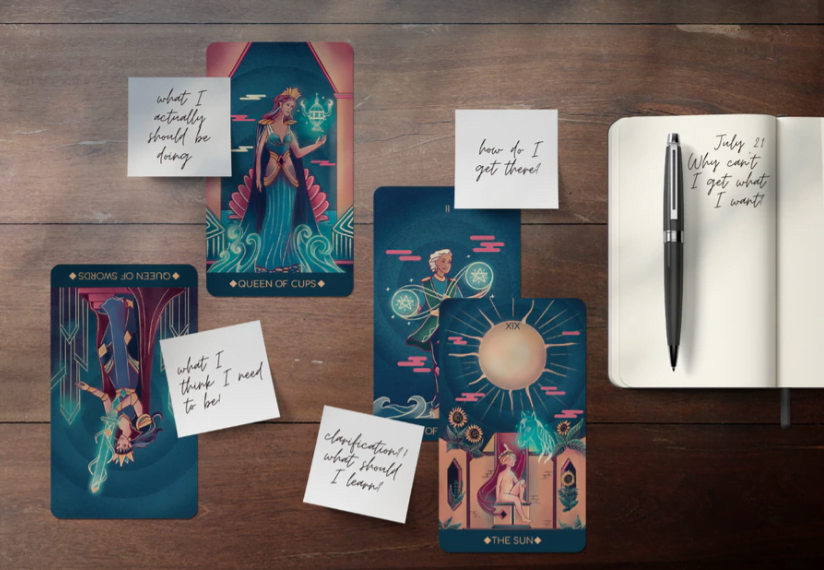In this article, we will talk about designing your own tarot spreads… How do you make a tarot spread? Do you need to be a professional tarot reader?
In fact, you don’t have to be able to do a professional tarot reading to create your own tarot spread. In fact, when you’re just a beginner tarot reader, it’s even better to start working on designing your own tarot spreads.
This helps you learn how to do tarot reading in a different way than other people know. It even means you can develop your own tarot spread to all those questions your friends will ask you.
My Own Tarot Spread
I was browsing Pinterest the other day. Some of you know how it is.
When the time for a tarot reading comes, you either get lost in endless scrolling for that one tarot spread that fits your specific situation or find yourself sticking to the same old common tarot spreads you’ve learned by heart because browsing in front of someone else feels unprofessional.
Truth is, you don’t have to follow a pre-scripted formula! There are as many tarot spreads as there are readers. That’s why you can find many tarot spread templates made by various spiritual content creators online.
Today’s post dives into the key tips of designing — or improvising on the fly —your own tarot spreads for yourself and others, so you always know how to ask the right questions to get as close to a clear answer as possible.
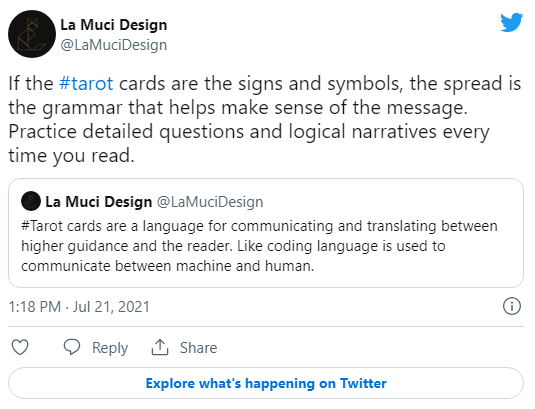
Unique Tarot Spreads
If you want to create your own unique tarot spread, you can follow the steps below:
Focused questions
A tarot spread requires interpreting the cards in context, not alone. When you create your own tarot spread, you can start by focusing on the questions first.
In a previous post, I compared tarot to a language — like coding as a means of communication between human and machine. Following that analogy, if the cards are the words, the spread is the grammar.
Most tarot spreads you will see come with questions for every tarot card, such as
- “What is currently blocking me?”.
Sometimes these templates contain no more than statements, such as “Your Feelings” and “Their Feelings”. Here, the real key for creating own tarot spread is to know what kind of answer you’re looking for. By that, I don’t mean “I want the answer to be wealth”.
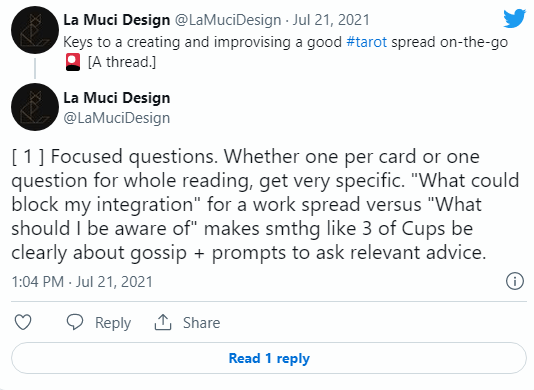
Let’s imagine you’re doing a spread about your new job
- If you ask, “What is something to be aware of?” and you got the Three of Cups,
you’re quickly going to realize that answer is too broad to interpret.
If instead of ‘aware’ you used the word ‘cautious’, suddenly the Three of Cups looks a lot like gossip.
- If you went even more specific and asked, “What could hinder my integration into the new workplace?”
Then the Three of Cups is not only providing you with a more specific warning with consequences, but opens a window for you to ask the correct kind of advice!
That being said, some tarot readers don’t assign every tarot card a specific question. That means, you can create your own tarot spread without being a professional tarot reader.
I watched this YouTuber called EsoTarot the other day, and she usually starts by asking just one focused question repeatedly, after which she typically pulls 8-10 cards and just interprets them. Yet, why does this also work?
Because of the next key!

Agreements and instructions about tarot card’s meaning
You know those playful agreements we make with ourselves, like “If I successfully throw this ball into the basket, I will ask my crush out”?
Before you start drawing the cards and creating new tarot spread, it’s good to at least have a rough idea of what kind of engagement you’re going for. This can depend on the card designs. Still, you should never go with just ‘whatever comes out’.
Sometimes this can be part of the construction of focused questions, like adding an instruction of “Show me in a way I can understand”, if you’re more into interpreting visuals and symbolism of tarot cards.
Are you looking to tell a story with tarot spread?
Then ask for the cards to present themselves in chronological order.
Some tarot readers, instead of drawing cards, search through the tarot deck for a specific card — like if you’re reading for a Scorpio and agree with yourself that the answer to their question will be next to the Death card in upright.
You might feel mid-shuffling like you want to answer a question using two cards:
- One for whoever is asking and
- The second for whom they’re asking about, for example.
Once that decision comes to your mind during a tarot reading, stick with it.
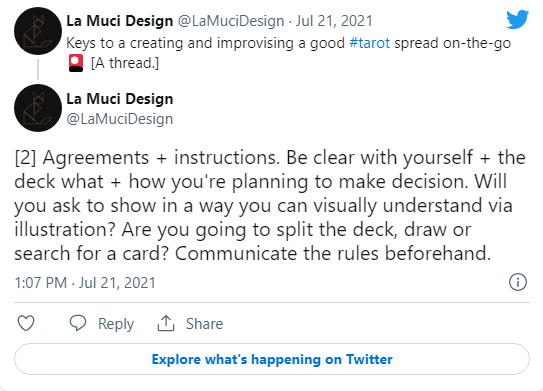
- You can also read: Can You Learn Tarot On Your Own? Start Off Accurate Tarot Reading
3. Clarifiers
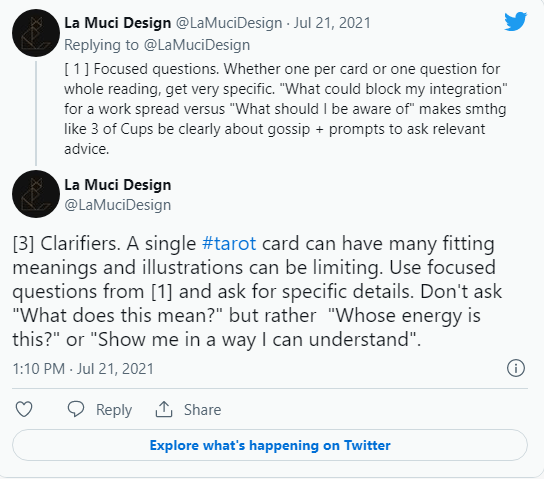
A painting is worth a thousand words, but when we want clarity and conciseness a thousand words is a bit too much. Which is why when we can’t quite put a finger on what the card is saying, pulling our more cards to clarify is always a yes!
4. Healthy & Critical Balance About Tarot Spread
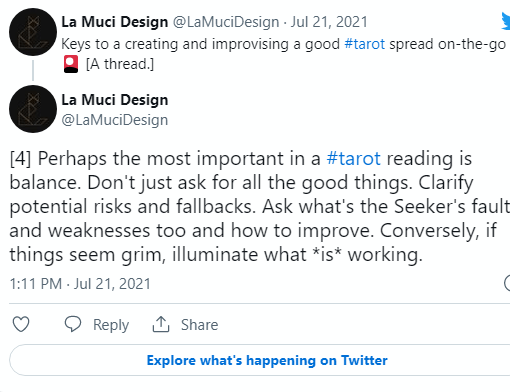
Remember the differences between what you want to hear versus what you need to hear while designing your own tarot spread.
The sugar and spice.
The light and the dark.
In the words of Albert Einstein, “Energy cannot be created or destroyed”. So when one aspect of life or a situation may be lacking, things might be overflowing elsewhere – and vice verse.
A tarot spread works best when working with extremes rather than staying in the neutral grey. Always try to analyze both sides of a coin, potential loopholes and don’t shy away from asking “What is something I’m in the dark about?” or completely forgetting.
5. Narrative
Beginning, middles and ends.
When we open ourselves to receive and channel guidance through tarot cards, you want to feel informed upon finishing a tarot reading a releasing the energy.
While designing your own tarot spread and analyzing a situation or possibilities, it’s important to understand where this energy began or what is the source of a certain chain of events.
Closure is equally important. If you’re looking to gain clarity, but a tarot reading left you confused and lost, don’t wrap it up just yet.
You can now look at ways to work and improv on the situation. Similarly, you wish to guide the person you are reading to towards discovering answers and actions that will help them coordinate themselves moving forward.
Post Scriptum
Did you find this helpful? If you came this far and still feel like you have questions left or would like me to clarify on anything, let me know in a comment or on Social Media, I’ll gladly update or even write another post about it!
Let’s Practice to Creating Your Own Tarot Spread
I thought of a new way to engage with you: practicing tarot spread interpretations!
I’m calling it #TarotTuesday. (Though I was so excited and wanted to have this put together for today’s post and posted on a Wednesday this one time!) This is how it works:
I give you a tarot spread and a situation, and you comment how you would advise the hypothetical person based on the cards. Hope it catches on! Share it with anyone and all you know practice tarot.
Now you know more about creating your own tarot spread. Then I suggest you take a look at my article titled “How To Do A Yes or No Tarot Reading For Quick Answers?”…
